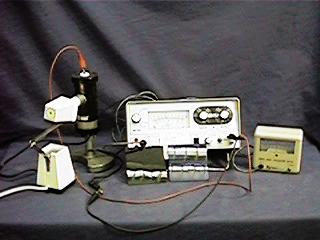 |
 |
 |
 |
 |
 |
 |
 |
 |
 |
 |

|
The photoelectric effect |
|
| By clicking on the picture, you will see a video clip of the photoelectric effect happening in real time. A light shines in a photo tube (which has a pottassium plate). You can observe how the current is affected by the colour (wavelength) even though the intensity is not changed. When the red filter is applied, the current drops to zero, as red has a lower frequency than blue. | |
|
So what does this tell us? The energy of a photon is based only on its frequency (which is inversely proportional to its wavelength). So, as the wavelength is decreased, the energy of the photons increases. Eventually the photons become energetic enough, that when they give their energy to the electrons, those electrons have enough energy to escape from the plate. This is the point when we see the electrons begin to move. This shows that the energy of photons is based on its wavelength. Now what about light being particles? First, we have to realize, that if we are now thinking of light as a particle, we have to change the way we think about intensity. In a wave, intensity refers to the amplitude of the wave. Now that we are thinking of light as a particle, the intensity refers to the number of particles. When the intensity of the light is increased (the number of particles of light is increased), we see that the only effect it has is in increasing the number of electrons which come off the plate. Therefore, in order to get more electrons to come off, we need more photons!
Why is this big deal? Let us take the classical example of shaking a rug to get the dust off of it. If you shake the rug very hard (giving it a greater amplitude), you will do two things, 1-increase the number of dust particles coming off the rug, and 2-increase the energy of those dust particles are coming off. This is common sense to us! However, in the case of the photoelectric effect, how hard you shake the rug has NO effect on the energy of the dust particles. In some cases, you can shake it as hard as you want and not a single particle will come off the rug. | |


 <-- Intensity -->
<-- Intensity --> 